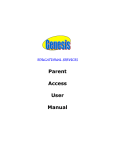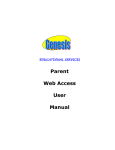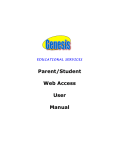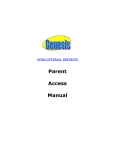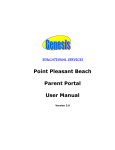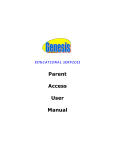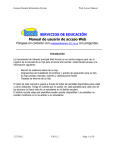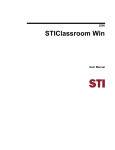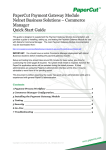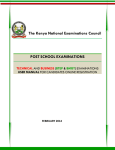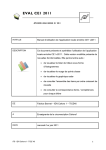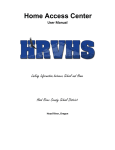Download Parent Access User Manual - Montville Township School District
Transcript
EDUCATIONAL SERVICES Parent Access User Manual Genesis Student Information System Web Access Manual GENESIS STUDENT INFORMATION SYSTEM PARENT ACCESS I II III Introduction Logging In & Logging Out Student Summary Dashboard (Home) Screen A. Viewing the Dashboard B. Choosing a Student IV Attendance A. Daily Attendance B. Class Attendance V Grading See a student’s most recent report card VI Discipline VII Gradebook A. Weekly Summary and Marking Period Averages B. List of Assignments C. One Day’s Assignments D. One Week’s Assignments E. Special Grades and the Previous Grade Column F. Viewing Teacher’s Comments G. Downloading Attached Documents VIII Scheduling (Next Year Scheduling) X IN-BOX XI Documents IX Contact Management – Managing Information for School XII Payments p. p. p. P. P. P. P. P. P. P. P. P. P. P. P. P. P. P. P. p. p. p. p. IX P. P. P. P. P. X Setup A. Introduction to the Setup Screen B. Changing your Password C. Selecting your Home Screen D. Adding Contacts for Email and Emergency Broadcasts E. Setting Alerts FAQ 10/7/2011 V2011.2 3 4 6 6 7 9 9 10 11 12 14 15 15 17 18 19 19 20 21 22 25 27 28 p. 36 39 39 40 40 41 P. 42 P. 43 Page 2 of 42 Genesis Student Information System I. Web Access Manual Introduction The Genesis Parent Parent Access tool is a safe, secure way to view your child’s school record for the current school year. If your school district chooses, you may have access to the following information: - Contact Information (email, phone numbers, emergency contacts) for your children - Your children’s Marking Period, Exam and Final Grades - Your child or children’s Report Cards - Your child or children’s daily attendance record and possibly class attendance records (if your child’s school uses class attendance). - Teacher Gradebook assignments and assignment grades for your child or children. - Your child or children’s course requests or possibly their schedule for the next school year. - Your child or children’s discipline records - Letters sent to you regarding your child: o General Purpose letters o Attendance Letters o Discipline Letters o Scheduling Letters o Fines/Fees Letters - Documents that have been uploaded for your students. The rest of this manual will guide you through all of the screens which may be available to you and how to use them. Please be aware that you may not see every screen for every one of your students (if you have more than one student in the school district). The school district chooses which screens can be made available. Screens may not be displayed if they do not apply to your student. 10/7/2011 V2011.2 Page 3 of 42 Genesis Student Information System II. Web Access Manual Logging In & Logging Out Logging In Logging into Genesis is very simple: 1. Click on Parent Access on the district’s web site. 2. Enter your Email Address in the ‘Username’ field 3. Enter your Parent Access password in the ‘Password’ field. 4. Click the ‘Login’ button Logging In for the First Time The very first time you login you will be required to change your password. What if I forget my password? If you forget your password, click on the Forgot My Password link. Logging Out It is important to log out of Genesis Parent Access properly: It is important to log out of all web applications properly. 10/7/2011 V2011.2 Page 4 of 42 Genesis Student Information System To logout, locate the Web Access Manual icon in the upper right corner of every screen and click it: To logout, click the logout icon in the upper right corner of the screen. When you click the logout icon you are immediately logged out: Why log out? Why not just close or “nuke” the browser? Closing the browser without logging out leaves your session open on the Genesis servers. This creates a security hole that only you can close: Be secure, always log out properly. In this era of Internet access, it is important to always properly close your sessions so that unauthorized persons cannot gain access to your information. This applies not only to Genesis, but to every Internet/Web application you use. 10/7/2011 V2011.2 Page 5 of 42 Genesis Student Information System III. Web Access Manual Student Summary Dashboard Screen A. Your “HOME” Screen - The Student Dashboard The highlighted course is the one the student is scheduled to be in ‘right this very minute’. Genesis Parent Access “Home” – Student Dashboard Screen When you login to Genesis Parent Access the first screen you see is Parent Access “Home”. This is the Student Dashboard screen. You will see a ‘dashboard’ for every student linked to your login. Each student’s ‘dashboard’ contains the following information: • Basic information about the student: student id, homeroom, grade, age. If you are viewing the screen during the school day, you will also see information about the class your student is in ‘right now’: current class, current teacher and current room. • Your student’s schedule. The class the student is in ‘right now’ is highlighted in green. • The student’s attendance summary for the current week – this shows you a color coded attendance code for each of the week. • Assignment summary for the current week – how many are due each day • Optionally, the student’s bus assignments will be displayed. 10/7/2011 V2011.2 Page 6 of 42 Genesis Student Information System Web Access Manual This is the currently selected student. The dark blue tabs give you more information about one of the students – the currently selected student. Figure 1 – Screen view without Bus Assignments displayed More Information About Each Student The ‘Parent Access Home’ screen has a dashboard for each of your students. The other tabs give you more information about one student at a time. Bus route information may also appear in your child’s dashboard. Counselor name If your child has a schedule (in high school or middle school), click the icon to get a printable copy of their schedule. The Selected Student Only one student can be ‘selected’ at one time. When you ‘select’ a student that student’s information will appear when any of the additional tabs are clicked. For instance, if you click the ‘Attendance’ tab, you will see the selected student’s daily Attendance calendar for the entire school year. 10/7/2011 V2011.2 Page 7 of 42 Genesis Student Information System Web Access Manual B. Selecting a Student Changing the Selected Student The name of the ‘currently selected student’ is displayed in the ‘Select Student’ drop down at the top of the screen. To pick a different student, click the Select Student drop down and choose the name of the student you want to select. Once you have done that, the tabs will take you to the newly selected student’s information. The “Select Student” Drop Down This drop down contains the names of all the students that you have access to. If you are missing a student, please contact your school or district office. Your district may require you to submit a separate permission slip for each student. 10/7/2011 V2011.2 Page 8 of 42 Genesis Student Information System Web Access Manual Attendance IV. A. Daily Attendance Daily Attendance is your child’s official daily attendance. Student’s attendance summary for the school year. This is your student’s Daily Attendance summary for the whole school year. • • • The Attendance Calendar with each day color coded A summary of the student’s Attendance for the year The ‘Legend’ of Attendance codes for your school district. Attendance Color Codes Your district selects its own set of Attendance codes and selects the color for each one. When you look at this screen you will see the Attendance codes for your school district. Common Attendance codes include: - Unexcused absence - Excused absence - Unexcused tardy - Excused tardy - Left early - Field trip 10/7/2011 V2011.2 Page 9 of 42 Genesis Student Information System Web Access Manual B. Class Attendance If your child is in Middle School or High School and has separate courses, Class Attendance may show you their attendance for each separate subject. You must click the tab under to find class attendance. If this button does not appear, your child’s school does not record individual class attendance. Student’s attendance To see Class Attendance, click the summary for each class by tab Marking Period. The Class Attendance screen shows you your student’s Class Attendance summary for each of their separate subjects. One month is displayed at a time and the screen always starts by showing you the current month’s attendance. You may select any month you wish. • • • • Class attendance is listed by each school day in the month and shows which classes the student may have missed on each day. Each day for each subject is color coded. The ‘Legend’ of color‐coded Attendance codes for your school is shown at upper right. “Today” is always highlighted in yellow (e.g. above 11/21/2008). Along the right side of the screen there is a separate summary for each subject for the entire school year, divided by Marking Periods. Each subject summary contains the following attendance totals for the class: All ‐ All absences for the subject, U – the Unexcused absences E – the Excused absences 10/7/2011 V2011.2 Page 10 of 42 Genesis Student Information System V. Web Access Manual Grading The Grading screen gives you access to your student’s Marking Period grades and teacher comments and possibly the student’s most recent actual report card. The current Marking Period is shown in green (typically it will not yet contain grades). Tool tip The comments listed below the grades correspond to the comments your student has received in their classes. Place your cursor on a comment and the corresponding text will be highlighted. The Grading Screen This screen summarizes your student’s Report Card grades for the current year. The current Marking Period is highlighted in green. Each box shows the grade and comment codes that your student has received in the corresponding class for the selected Marking Period. If you place your cursor on a comment code (e.g. 03), the corresponding comment will be highlighted (e.g. ). In addition, the text of the comment will appear in a tooltip (e.g. ). In addition, as outlined below, you can access and view your student’s most recent report card. 10/7/2011 V2011.2 Page 11 of 42 Genesis Student Information System Web Access Manual Viewing your Child’s Most Recent Report Card If you are able to view your child’s actual report card, a “Please click here to view” message will appear between your child’s name and their list of grades: If this message appears, click it to view the actual report card displayed in Adobe Reader (Adobe Reader must be installed on your computer). A sample report cord is shown below. Adobe Printer icon Procedure to Print a Copy of the Report Card 1. Click on the ‘Setup’ tab. 2. If the “Please click here to view” message appears, click it. If it does not appear, you will not be able to view your child’s actual report card at this time. 3. When the report card appears, locate the Adobe printer icon at the upper left of the Adobe Reader’s border. Click it to access a regular Print dialog and print the report card. Procedure to Save a Copy of the Report Card 10/7/2011 V2011.2 Page 12 of 42 Genesis Student Information System Web Access Manual 1. Click on the ‘Setup’ tab. 2. If the “Please click here to view” message appears, click it. If it does not appear, you will not be able to view your child’s actual report card at this time. 3. When the report card appears, locate the Save icon at the upper left of the Adobe Reader’s border. Click it to access a regular File dialog and print the report card. Procedure to Return to the Genesis Parents Module 1. When you are done viewing the report card, click the browser “Back” button. 10/7/2011 V2011.2 Page 13 of 42 Genesis Student Information System VI. Web Access Manual Discipline Discipline Record The screen lists any discipline issues regarding your child that have occurred in the current school year. Each incident record includes the following information: • The date and time period in which the incident occurred. • A brief description of the incident • A list of all actions that have taken place or will take place as a result of your child’s involvement in the incident • Dates on which the actions were or are scheduled to take place. This screen is optional and may not be available in your child’s school. 10/7/2011 V2011.2 Page 14 of 42 Genesis Student Information System VII. Web Access Manual Gradebook A. Weekly Summary of Assignments Screen and Marking Period Averages Click on the highlighted course name to see all the Assignments for that course. A list of Courses with Assignments by Day of the Current Week This screen lists all courses your child is currently taking. Marking Period Averages for the Courses The “Avg” column shows you your student’s current Marking Period average – for the current or a previous Marking Period. A ‘projected’ alpha grade may also appear if your school uses alpha grades. Viewing all Assignments for One Course To see all of the Assignments for one course, click on the highlighted course name. That will take you to the “One Course/All Assignments” screen. Viewing all Assignments for a Selected Day To see all of the Assignments for one day (for example, Tuesday), click on the highlighted day name. That will take you to the “One Day/All Assignments” screen. 10/7/2011 V2011.2 Page 15 of 42 Genesis Student Information System Web Access Manual To select a different week, click here. To see one day’s Assignment’s click on the highlighted day To see your child’s average in a previous Marking Period, use the drop down to select the one for which you want to see their average Figure 2 – GradebookÆWeekly Summary Screen Gradebook Weekly Summary This shows you a snap shot of all Assignments that are due for the selected week. You may do the following: • Select a different week by clicking in the “Week of” field • See all the Assignments for one course by clicking on the highlighted name of a course in the list • See all the Assignments for one day by clicking on the highlighted day name • See your student’s marking period averages for either the current Marking Period or a previous Marking Period. Choosing the Marking Period Average to Display The “Avg” column always starts by displaying your student’s up‐to‐date Marking Period average for the current (i.e. ongoing) Marking Period. You can check on their average for a previous Marking Period by using the drop down in the “Avg” column header: Select the Marking Period and the averages in the column will be updated to show you the averages for that Marking Period. If you tab away from this screen and then return, the averages for the current MP will once again be displayed. 10/7/2011 V2011.2 Page 16 of 42 Genesis Student Information System Web Access Manual List of Assignments Screen List of Assignments This screen will allow you to look at your child’s Assignments in multiple ways. The controls at the top of the screen let you select by the following criteria: • • • • Courses – Select one subject or all subjects Status – o Graded Assignments – Assignments that have been graded. o Ungraded Assignments – Assignments that the teacher has not yet graded. o Incomplete Assignments – Assignments the student has partially but not completely finished. o Missed Assignments – All assignments the student failed to turn in or do. o Assignments the student has not yet completed because they were absent on the due date. An assignment is marked “Absent” if the student is absent on the day it is due. This option shows all assignments currently marked “Absent”. Assignment Due Date – Select one date. This date can be interpreted as the single date you selected or as the week which contains the date you selected or as the month. Show Assignment Dates – This lets you choose the time period you wish to view assignments for: o “One day” – the Assignments for the date selected in Assignment Due Date. o “Week of” ‐ the Assignments for the week which contains the date selected in Assignment Due Date. o “Month” ‐ the Assignments for the month which contains the date selected in Assignment Due Date. o “MP1” – All assignments for Marking Period 1. o “MP2” – All assignments for Marking Period 2. o “MP3” – All assignments for Marking Period 3. o “MP4” – All assignments for Marking Period 4. o “All Assignments” – All assignments for the entire duration of the course. 10/7/2011 V2011.2 Page 17 of 42 Genesis Student Information System Web Access Manual B. One Day’s Assignments One Day’s Assignment When you click on a ‘day’ name you are brought to the “List Assignments” screen with only the one day selected: These two drop down boxes are set to ‘all courses’ and ‘all assignments’ These two drop down boxes are set to the selected day. Figure 3 – The “List Assignments” screen in “One Day/All Assignments” mode One Day/All Assignments If you click on a day name, you come to the “One Day/All Assignments” screen. This is the “List Assignments” screen set for one day, all courses, all assignments. 10/7/2011 V2011.2 Page 18 of 42 Genesis Student Information System Web Access Manual C. One Week’s Assignments Viewing a Week’s Assignments If you select “Week of” and select any date, you will be shown all assignments for the week containing the selected date. For example, if you select the date “11/21/2008” which happens to be a Friday, you will be shown all assignments for the week Monday, 11/17/2008 through Friday, 11/21/2008. If “Week of” is selected, selecting any date will show that week’s Assignments Previous grade column Figure 4 – A view of the List Assignments screen for 1 week, with the “previous grade” column D. Special Grades and the Previous Grade Column (“Prev”) Teachers have 4 "special" grades that they can give students for any assignment: • Absent – Your child was absent on the date the assignment was due. This means your child has a chance to make up the work: The assignment is not counted until the teacher changes the grade to a regular grade or to Missing or Incomplete. When a grade of Absent is changed to another grade, “Absent” appears in the column. • Missing – Your child failed to turn in an assignment or take a quiz or a test. When a Missing is changed to another grade, appears in the column. Missing is the most common special grade. A teacher’s comment may accompany a missing. • Incomplete – Your child partially completed an assignment but did not finish it. When Incomplete appears in the column, your child has completed the assignment late. • Exempt – Your child is not responsible for doing this assignment. It does not count for them. It is unusual for an Exempt to appear in the column. Initially, these special grades appear in the regular column (e.g. ). When a teacher gives one of these special grades (e.g. ‐ Missing) and then later changes it to another grade, the original, special grade (i.e. ) is displayed in the column on the List Assignments screen. Regular grades never appear in the column – it is only for these special grades. The teacher cannot clear the “previous grade”. It is always displayed to you. You might use this information to help understand why your child may have received their regular grade (“the work was late”). For example, excellent work turned in late often receives a reduced grade. 10/7/2011 V2011.2 Page 19 of 42 Genesis Student Information System Web Access Manual E. Viewing Teacher Comments Viewing Teacher’s Comments Teachers can enter comments on your child’s performance that can be viewed through the List Assignments screen. If a teacher has entered a comment on an assignment, please take time to view it. If a pushpin icon appears on the far right side of an Assignment line, it means the teacher has entered a comment on the assignment. To read the comment, place your cursor over the icon. This will cause the comments to popup in a tooltip box: Ñ F. Downloading Attached Documents Downloading documents from Teachers Teachers can upload documents to assignments so that you can download these at home. The “documents” include such things as MS Word, MS Excel, PDF files, .wmv movies, podcasts and many other types of files. When one or more documents have been uploaded and attached to an assignment, icons identifying the type of each attachment appear in the Docs column on the List Assignment screen. If icons (e.g. ) appear in the “Docs” column on the right side of an Assignment line, it means that the teacher has uploaded documents to the assignment and you may download these. There will be one icon for each document the teacher has attached ( means there are two documents attached, one attached to each icon). The shape of the icon indicates the kind of file that is attached (e.g. indicates a PDF file that requires ADOBE Reader to read). You will need to have installed the right application to view each type of file.1 To see the description of an attached document, place your cursor on the icon: (cursor on PDF icon) (cursor on camera icon) 1 While teachers are encouraged to upload files in common formats, such as MS Word, there is no guarantee that you will always have the right application to view an attachment. If you do not, please contact the teacher. 10/7/2011 V2011.2 Page 20 of 42 Genesis Student Information System Web Access Manual To download the document, double click on its icon. The attachment will be displayed in the central part of the screen: Click “Search” to return to the list of Assignments. 10/7/2011 V2011.2 Page 21 of 42 Genesis Student Information System Web Access Manual VIII. Scheduling The Scheduling screen shows you your student’s course requests for the next school year (e.g. 2010‐2011 if this year is 2009‐10), as well as their “next year” schedule once one has been created. There are three things listed on this screen: 1. Your student’s list of course requests for next year. These can be printed out. 2. The teacher a course was recommended by – if there was a teacher recommendation. Teacher Recommendations will appear at the very bottom of the screen. 3. Once the student’s actual schedule for next year is ready, it will be displayed on this screen as well. This may not happen during the current school year. When the next year schedule is ready, you will be able to print it out as well. Printing Next Year’s Requests 1. Click the PDF Icon next to the “list of requests” header: This brings up an Adobe PDF view of your student’s next year requests (shown below). The printed report includes a “signature” line. 2. Use the Adobe Reader’s print button to send the report to the printer. 3. You may be asked to do print the request list, sign the set of requests and have your student return the signed list to school. 10/7/2011 V2011.2 Page 22 of 42 Genesis Student Information System Web Access Manual Figure 5 – Adobe PDF report of your student’s next year course requests. Use the Adobe Print button to print this on your printer. Printing Next Year’s Schedule Your student’s next year schedule will only be available once the scheduling process completes. This may not occur until after the end of the current school year. Scheduling is a long and complicated process. An empty or missing schedule simply means that your student’s school has not yet completed the scheduling process and is not a cause for alarm. 1. Click the PDF Icon next to the “Next Year Schedule” header: This brings up an Adobe PDF view of your student’s next year schedule. Figure 6 – Sample Next Year Schedule displayed in Adobe Reader. 2. Use the Adobe Reader’s print button to send the report to the printer. Courses Recommended but Not Requested 10/7/2011 V2011.2 Page 23 of 42 Genesis Student Information System Web Access Manual The very bottom of the Scheduling screen may contain a list of courses that teachers recommended for your student but which they decided not to request and not to take. Figure 7 – The “Course Recommendations which have not been Requested” list from the bottom of the Scheduling screen This list will appear if a teacher recommends a course for your student and your student decides not to take the course. The course is then “not requested” so that it will not be scheduled for your student. Figure 8 – Another view of the Scheduling tab 10/7/2011 V2011.2 Page 24 of 42 Genesis Student Information System Web Access Manual IN-BOX IX. The IN‐BOX tab contains a list of letters that have been generated and sent to the student’s guardians. Once the letter has been sent to the guardian, it can be made available on the Parent Access IN‐BOX screen. To view a letter, click the PDF icon corresponding to it. Figure 9 – View of the IN-BOX tab To view a letter, click on the PDF icon corresponding to it. This will open a separate window and display the letter: Figure 10 – Sample Letter Display – letter is displayed in a separate web browser window. When you are finished viewing the letter, you may close the window it is displayed in. 10/7/2011 V2011.2 Page 25 of 42 Genesis Student Information System Web Access Manual Printing Contact Reports All Genesis reports are displayed as PDFs using Adobe Reader. To print on a printer, use the Adobe Printer icon to bring up a normal print dialog. What types of Letters are displayed? • Attendance Letters – Letters generated when the student has some Attendance‐ related issue (e.g. too many absences). • Conduct Letters – Letters generated when a student is involved in a discipline infraction. • Scheduling Letters – Letters related to scheduling classes for next year. • General purpose letters – Any letter that does not fall into one of the above categories is considered “general purpose”. These can cover a wide variety of topics. 10/7/2011 V2011.2 Page 26 of 42 Genesis Student Information System X. Web Access Manual Documents The Documents screen lists documents that the school or district has linked to your student’s record. You can view these and maybe asked to acknowledge that you have read one of them: The documents you have access to are displayed in the “Document Library” list on this screen: Download and View a Document To download and view a document listed on this screen, click the the contents of the selected document. PDF icon. This displays Acknowledge that you have read the Document To acknowledge that you have read the corresponding document, click the button. This causes a confirmation dialog to appear: You must type the word YES (all in capital letters) into this dialog box and click the OK button to acknowledge that you have read the corresponding document. WARNING: Clicking the button and entering YES into the prompt is a legal acknowledgement that you have read the document. Once you have acknowledged reading the document, the button is no longer displayed: 10/7/2011 V2011.2 Page 27 of 42 Genesis Student Information System XI. Web Access Manual Contact Management The Contacts screen allows you to view and possibly update the contact information for your students. If you do not have permission to update the Contact information directly via Parent Access, you will not see the fields and buttons described here. If those fields and buttons are missing, please contact your school or district offices to update information for your children. A PDF icon should appear next to the name of each of your children to allow you to print out their current contact information. To get a report containing all contact information, click the PDF icon. Figure 11 – View of part of the Contacts Screen listing all Contact Information for your students. The PDF icon at the top can be used to get a PDF report of all of the information displayed on this screen. What is listed on the Contact Management Screen? The Contacts screen lists all telephone and email contact information for: - The student themselves – your children’s own cellphone and email addresses - The student’s Guardians – The legal guardians – such as yourself – who are allowed to view the children’s information. - Other contacts – all other people whom you wish the school to be aware of in your children’s lives, including: o Emergency contacts – People you wish to be contacted should an emergency arise and you are not available. o Doctors o Dentists o Hospital to use in an emergency if hospitalization is required. o Other people it is important that the school know about. 10/7/2011 V2011.2 Page 28 of 42 Genesis Student Information System Web Access Manual The Contacts screen has an area for each of your children and within a child’s area, there is a separate section for each Contact. Viewing and Printing Contact Information for all Students linked to your Account To print a copy of all of the contact information found on the Contacts screen for one student, locate the PDF icon next to the student’s name and click it. This will bring up a report of this student’s Contact information: Click this icon Figure 12 – The Contacts Report for one student – These reports maybe multiple pages. The Contact Report: The report is always for one student. Each student listed will have a PDF icon next to their name which can be clicked for that student’s Contacts report. The reports can be multiple pages. Make sure you scroll down to see all of a student’s Contact information. This report can be printed out, corrected and brought to your child’s school or district offices. Printing Contact Reports All Genesis reports are displayed as PDFs using Adobe Reader. To print on a printer, use the Adobe Printer icon to bring up a normal print dialog. 10/7/2011 V2011.2 Page 29 of 42 Genesis Student Information System Web Access Manual Figure 13 – Scroll down to view additional students and contact information Interpreting Information for a Contact The Contacts screen Each “Contact” represents one person in a student’s life (e.g. Mother, Grandmother, Uncle), or a single organization (e.g. Doctor’s practice, Hospital). The top line shows the Contact’s name and “contact type”: There are multiple contact types that are possible: - Student - Guardian 1 10/7/2011 V2011.2 Page 30 of 42 Genesis Student Information System - Web Access Manual Guardian 2 Guardian 3 Guardian 4 Phone Numbers: A Contact may have an unlimited number of phone numbers listed for them. If a number is a cell number and you want the Contact to receive text messages on their cell phone regarding your child, you must select the name of the cell service provider (e.g. Verizon, AT&T, Sprint, T‐Mobile, etc.). If you have permission to remove phone numbers, a trashcan icon will appear at the far right of each phone number: Email Addresses: A Contact can have multiple email addresses listed. If a small icon appears at the right side of the email address, it means that this email address is being used as the login for a Genesis login for your child. For example, it may be your email address and indicate that you have a Genesis login: The Student’s Own Contact Information Each student can have their own, personal phone numbers and email addresses listed under the “Student” contact. These would be ways for the school to contact the student, themself, directly. 10/7/2011 V2011.2 Page 31 of 42 Genesis Student Information System Web Access Manual Updating Information for a Contact Each section contains information for a single Contact: Figure 14 – Information for one Contact Each “Contact” represents one person in a student’s life (e.g. Mother, Grandmother, Uncle), or a single organization (e.g. Doctor’s practice, Hospital). You MAY be able to update the Contact information directly on the screen: this is under the control of your school district. They may allow you to update the information directly, or you may only be able to view it. Updating a Contact’s Email and Phone Numbers You can do three things to the email addresses and phone numbers: - Change the information - Remove (i.e. delete) the information - Add new phone numbers and email addresses WARNING: You can only do these things if your school district gives you permission. This section assumes that you have such permission – if you cannot do the things described here, it is because your district has not given you permission to do them: it is not because the system is broken. 10/7/2011 V2011.2 Page 32 of 42 Genesis Student Information System Web Access Manual Deleting a phone number or email address: Find the delete trashcan icon corresponding to the phone number or email you wish to delete and click it: A confirmation dialog will appear: Click the OK button to continue and delete the email address or phone number. Click Cancel to abandon the deletion and keep the information. Adding a phone number or email address: To add a new phone number or email address locate the “Add Phone/Email” tool at the bottom of the Contact’s information: Make sure you locate the Add Phone/Email for the correct Contact. Each Contact has their own Add Phone/Email field: The drop down contains the list of things that you can add to the Contact: You may only add the types of things in this list. If it is missing, you do not have permission to add it (e.g. if “Email” is missing you do not have permission to add Emails. Select the type of information you want to add. Then move to the blank text field and enter the phone number or Email address. Go to the top or bottom of the screen and click the button. Adding a Cell Provider information to an existing phone number: For Genesis to send text messages to a Cell number, the cell service provider (e.g. Verizon, AT&T, Sprint, T‐ Mobile) must be specified. It is not possible to send text messages without that information. “Text messages” include the notifications that can be sent, for example, when a student’s gradebook grades are updated. If the cell service provider is selected, but is wrong, the number will not receive the messages that are sent. To set or change a cell number, locate the “Provider” drop down to the right of the phone number itself: 10/7/2011 V2011.2 Page 33 of 42 Genesis Student Information System Web Access Manual Select your provider, then scroll up or down (to the top or bottom of the page) and click the button. Adding a New Contact If you have a button at the bottom left of a student’s list of contacts, you have permission to add a new contact! If you do not see that button, you do not have permission to add a contact: please contact your school to update contact information. To add a Contact, click on the button. This brings up the “New Contact” area right below the button: Enter the following fields: - Contact First Name – The person’s last name - Contact Last Name – The person’s first name - Relationship to Student – Select the new Contact’s relationship to the student: Friend? Neighbor? There are dozens of relationships listed. It is important to select the correct one. - Is the person an Emergency Contact for your child? Do you want them to be contacted in an emergency? If yes, select one of the Emergency Contact options. You can enter up to six emergency contacts for each of your students. Emergency contacts are people you wish to be called in the event of an emergency. Enter in the order in which you would like these people to be contacted. Once you have entered all the information, click the Contact. button to add the new WARNING: If you have more than one student, and you wish the new contact to be used for all your students, you must add them separately to each child’s contacts. Changing or Deleting an Existing Contact If you have permission to update information for a contact, there will be an button in the top line of the contact’s information. To update the name information for a contact or to delete the contact entirely, use this button: 10/7/2011 V2011.2 Page 34 of 42 Genesis Student Information System When you click Web Access Manual , a popup appears: The popup gives you three options: • ‐ Clicking the Close button dismisses the popup and makes no changes. • ‐ Clicking lets you change the name and relationship information for this Contact. • ‐ Clicking removes the contact entirely. This removes the whole contact: name, phone numbers and email addresses. Warning: There is no UNDO button. Deleting a Contact: When you click the following confirmation dialog appears: If you click Yes, the contact and all their information is permanently removed. If you click No, then the popup is closed and the contact is not deleted. Changing a Contact: When you click the following popup appears: You can change the contact’s first or last name, and set whether they are an Emergency Contact or not. To make changes to the contact, update the information, then scroll to the top or bottom of the screen and click the button. 10/7/2011 V2011.2 Page 35 of 42 Genesis Student Information System XII. Web Access Manual Payments The Payment screen, when it is available, allows you to pay fees for your children directly through the Genesis parent module using your Amazon account and services to make your payments. The Payment screen lists all fees for all your children at once (you do not need to select each child individually to see their fees): Figure 15 – The PaymentÆFees screen showing a list of all unpaid fees for all children associated with your Parent Access account There are three screens that are part of the payment mechanism. The first is the “Fees” screen which contains a list of all fees owed by all your children: Paying Fees: To pay one of the fees, either fully or partially, find it in the list of fees: Click the button to copy of the fee amount into the “Amount to Pay” field: Optionally, you can enter a partial payment amount (e.g. $50.00). 10/7/2011 V2011.2 Page 36 of 42 Genesis Student Information System Web Access Manual You can also enter payments for multiple fees. A total amount is displayed at the bottom of the list: To then move the payments to your Shopping Cart, click the button below the list. You will be prompted to make sure you wish to do this: To add the fees to your cart, click OK. Click Cancel to do nothing. When you have put all the fees you wish to pay into the Shopping Cart, you may click the button. This brings up your Shopping Cart screen: Clicking the button takes you to Amazon.com to complete your transaction: Use the Amazon payment control to pay for fees by credit card. 10/7/2011 V2011.2 Page 37 of 42 Genesis Student Information System Web Access Manual Amazon.com is the only way to pay. You must have an Amazon account setup in order to use this payment option. Viewing Payment History Your payment history is displayed on the PaymentÆHistory screen: The Payment History list shows you your completed transactions: The controls along the top of the list of payments also allow you to choose to view: - All your completed payments – those that you successfully paid (shown by default) Failed payments – Payments that did not complete for one reason or another. Successful and unsuccessful payments in one list Exporting to Excel: You can export your successfully completed payments to an Excel spreadsheet by click the “Download as Excel” icon button: the icon, the data is exported to an MS Excel spreadsheet. . When you click 10/7/2011 Page 38 of 42 V2011.2 Genesis Student Information System Web Access Manual XIII. Setup A. Introduction to the Setup Screen To get to the Setup screen, click the icon in the upper right corner The Setup screen is where you set up your Parent Access Module. You may only see the top part of this screen. Do not be concerned. Only certain features maybe be available. To get to the Setup screen, click the icon in the upper right hand corner of your screen. There are four functions located on this screen: 1. Changing your password 2. Selecting your “startup” screen 3. Managing your Email and Text Message Contact list (this may not appear) 4. Selecting Alerts (this may not appear) Each function has a separate “Save” button – when you make a change you must be sure to use the correct buttons. The following sections explain each of these functions. 10/7/2011 V2011.2 Page 39 of 42 Genesis Student Information System B. Web Access Manual Changing Passwords Procedure to Change Your Password 4. Click on the ‘Setup’ tab. 5. Enter your current password 6. Enter the new password you desire 7. Re‐enter the new password you desire. BE SURE TO WRITE DOWN YOUR NEW PASSWORD. 8. Click ‘Save’ When you are required to change your password If your password is changed by the system administrator, the next time you login, you will be required to change your password. The “Change Password” screen will automatically appear and you must do the following: 1. Enter your current password 2. Enter the new password you desire 3. Re‐enter the new password you desire. BE SURE TO WRITE DOWN YOUR NEW PASSWORD. 4. Click ‘Save’ C. Setting Your Home Screen Procedure to Change your Home Screen 1. Click on the ‘Setup’ tab. 2. Find the “Settings” section in the middle of the screen 3. Select your “Home” screen 4. Click ‘Save’ 10/7/2011 V2011.2 Page 40 of 42 Genesis Student Information System D. Web Access Manual Adding Contacts for Email, Text Messages and Emergency Broadcasts This area only appears if you have permission to set this information up in this way. It may not be available in this way on your version of the Genesis Parent Access. Contacts and the Genesis Emergency Broadcast System The contacts listed here – and controlled directly by you – will be sent email or text messages. Genesis includes an Emergency Broadcast System which allows your school or district to contact you in case of an emergency on your children’s school campuses. Email addresses may also be used to communicate with you by your children’s teachers. Procedure to Add a Contact 1. Click on the ‘Setup’ tab. 2. Find the “Your Contact Information” section in the middle of the screen 3. Locate the blank fields at the bottom of the contact list. Fill them in: a. Enter the contact Email or Cell # b. Select the name of the Cell Phone provider (e.g. Verizon, AT&T) c. If this contact should be used for Emergency Broadcast messages, check the “Emergency Broadcast” checkbox. 4. Click ‘Add’ Procedure to Change a Contact 1. Click on the ‘Setup’ tab. 2. Find the “Your Contact Information” section in the middle of the screen 3. Locate the Contact you wish to Change: a. Update the contact Email or Cell # b. Select the name of the Cell Phone provider (e.g. Verizon, AT&T) c. If this contact should be used for Emergency Broadcast messages, check the “Emergency Broadcast” checkbox. 4. Click the ‘Save’ icon button. Procedure to Delete a Contact 1. Click on the ‘Setup’ tab. 2. Find the “Your Contact Information” section in the middle of the screen 3. Locate the Contact you wish to delete and click the ‘Delete’ icon button. Please only add email addresses and text message phone numbers to which messages may be sent. 10/7/2011 V2011.2 Page 41 of 42 Genesis Student Information System E. Web Access Manual Setting Alerts Alerts Genesis has the ability to send an alert to your contact emails/text message addresses: - if your child is absent or tardy or - if a grade is updated in any of their teacher’s Gradebooks - If an Attendance letter has been generated for one of your children. You must turn on this feature and enter the email and text message addresses as described above in Section VIII D – Adding Contacts for Email and Emergency Broadcasts. Procedure to Turn On Alerts 1. Click on the ‘Setup’ tab. 2. Find the “Parent Notifications” section at the bottom of the screen 3. Check the Alert checkboxes for the alerts you wish to receive. 4. Click ‘Save’. Procedure to Turn Off Alerts 1. Click on the ‘Setup’ tab. 2. Find the “Parent Notifications” section at the bottom of the screen 3. Uncheck the Alert checkbox for those alerts you wish to turn off. 4. Click ‘Save’. 10/7/2011 V2011.2 Page 42 of 42










































